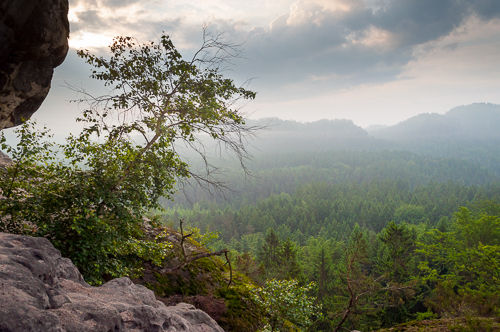I have been climbing, hiking and doing via ferrata a lot in the Elbsandstein mountains recently. I give a short overview of Saxon style climbing and a summary of the main via ferrata in the region.

The Elbsandstein mountains are magnificent! I have been there three times in the last three months, always for extended periods of at least three days up to a week. There is a lot to see. Even though I have been there regularly in the last couple of years, I am surprised that I can always find new and exciting places that I have not visited before.
The Elbsandstein mountains are an accumulation of sandstone mountains near the city of Dresden, located in the very east of Germany. A part of them lies on the German side and is called Sächsische Schweiz, while the second part is called Böhmische Schweiz and stretches along the Northern border of Czech Republic. On the German side, they reach a height of a bit more than 550 m above sea level.
Climbing
Climbing in the Elbsandstein mountains is quite popular. However, it is nothing for the faint-hearted. The climbing is mostly trad style. That means you bring and place nearly all of your safety gear. Because of the soft structure of the sandstone, you cannot use metal nuts and cams as you would typically do in other climbing regions. Instead, you use open slings placed over rock structures that are obtruding or thread them through rock tunnels. Hopefully thick ones.
Another component of the local climbing rack are knotted slings. They can be made out of regular climbing rope, accessory cord (Reepschnur), or special Kevlar cord that is particularly strong. The open end gets fixed with a figure-of-eight knot that is left pretty loose. This knot can then be placed into a crack in the rock, much like a regular nut. Through a firm pull, the knot tightens and grows in diameter, thus filling the whole crack. If done correctly, the firmer you pull the sling, the tighter the placement becomes, increasing the surface contact between sling and rock. This will hopefully improve the stability and safety of the placement. However, a single placement will probably not hold a hard fall, again quite similar to a metal nut. So place them often and spend some time to search for the most reliable placement. Your life depends on them to hold!
In the more difficult climbing routes, you will often find a few metal rings that offer a bit more protection but in the easier routes (below UIAA VI) you are mostly on your own.
Another speciality of Saxon climbing are the jumps! You will often find a gap of a few meters between the different sandstone columns that you have to cross by jumping over. The look into the abyss and the certainty that you will smash into the rock face if you do not make it, make them mentally quite challenging for the inexperienced climber. The real problem is that you have to find some safe hold on the other side of the gap which is obvious but can be sometimes hard in practice.
Hiking and Via Ferrata
I spent a significant fraction of my time in the Elbsandstein mountains not climbing, but hiking and doing via ferrata. They are also great for that! Most trails are flat enough even for inexperienced hikers if you do not take a lot of luggage with you. If you do, be prepared to suffer! Many peaks are easily accessible, and even more can be reached with just a short and easy scramble. The views are amazing! Especially in the morning, when fog from the night floats over the valleys.
I finally managed to ascend all three via ferrata in the region. Here are my impressions:
-
Häntzschelstiege
This is the longest one of the three and the one that feels most like a proper via ferrata. It consists of a shorter lower part and a longer upper part that leads through a chimney and out into the open. It offers incredible views at the top, but it can get crowded on the weekends. Via ferrata set recommended.
-
Zwillingsstiege
We were not that impressed. It is somewhat short (probably less than half of Häntzschelstiege), and the views are not that great compared to its bigger brother. We used our via ferrata sets only very sparsely.
-
Rübezahlstiege
This is the technically most difficult one. At least basic climbing skills are needed. There is no protection in place, except for a few metal clamps. The difficulty increases roughly in the middle. The access can be a bit hard to find. It is quite a journey down Heilige Stiege if you arrive from Affensteine. It should not be tried in the downward direction. Via ferrata set recommended. Hook it onto the metal clamps.
In total, it was a great time in a fantastic region! Click the link to see the photos.

